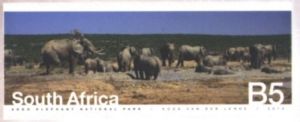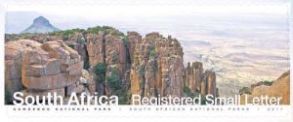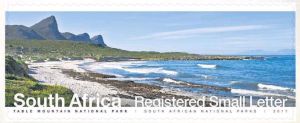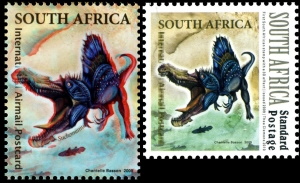the place where Paleontology and Paleoanthropology meets Philately
South Africa
Fossils and reconstructions of prehistoric animals and humans, paleontologists,
paleo-anthropologists, fossil found locations on postage stamps and postmarks
of South Africa
| << previous country | back to index | next country >> |
Contents:
- Country overview
- Philately of the South African Republic
- Official stamps of the South African Republic related to Paleontology
- Other stamps of the South African Republic to consider
- Commemorative postmarks of the South African Republic related to Paleontology
- References
- Acknowledgements
South Africa, officially the Republic of South Africa (RSA), is the southernmost country in Africa.
It is bounded on the south by 2,798 kilometres of coastline of Southern Africa stretching along the South Atlantic and Indian Oceans with population close to 56 million.
It is the only country that borders both the Atlantic Ocean and the Indian Ocean. South Africa shares borders with Namibia, Botswana, and Zimbabwe to the north and to the east and northeast by Mozambique and Eswatini (former Swaziland); and it surrounds the enclaved country of Lesotho.
Dutch traders landed at the southern tip of modern day South Africa in 1652 and established a stopover point on the spice route between the Netherlands and the Far East, founding the city of Cape Town.
After the British seized the Cape of Good Hope area in 1806, many of the Dutch settlers (the Boers) trekked north to found their own republics.
South Africa became independent in 1961. [R1]
South Africa contains some of the oldest archaeological and human
fossil sites in the world.
Extensive fossil remains have been recovered from a series of caves in Gauteng Province.
The area is a UNESCO World Heritage site and has been
termed the Cradle of Humankind.
The first stamp of the Union of South Africa was a 2 1⁄2d stamp issued on 4 November 1910. It portrayed the monarch King George V.
The first set of the Republic was issued on 31 May 1961.
From 1961 to 1966, stamps were inscribed "REPUBLIC OF SOUTH AFRICA REPUBLIEK VAN SUID-AFRIKA". However, from 1967 stamps were simply inscribed "RSA". Modern issues are just inscribed "South Africa". [R2]
South African Collectors’ Society (SACS), established in 1948, is an active Philatelic Society open to all collectors of the stamps, postal history, postcards and related ephemera of southern Africa.
Their local and international members’ collecting interests range from the pre-adhesive colonial era through to the present day.
If you collect pre-Union material, including the Colonies, States and Protectorates of southern Africa, or more modern Union and Republic of South Africa and Homelands, as well as the neighbouring territories of SWA / Namibia, the Rhodesias, Swaziland and the Portuguese colonies of Angola and Mozambique, you will feel at home in SACS among fellow, like-minded enthusiasts. The society issue "The Springbok" magazine on the quarter base.
Official stamps of South African Republic related to Paleontology: dinosaurs and other prehistoric animals, fossils, paleontologists
| 01.12.1982 "Karoo Fossils" | 09.10.1991 "South African Scientists" [1] | 28.06.1998 "Early History" [2] |
 |
 |
 |
| 22.09.2000 "World heritage sites" [3] | 10.11.2006 "Origin of Humankind" | 02.11.2009 "Dinosaurs" [4] |
 |
 |
 |
| 09.10.2010 "Celebrating Print Techniques on South Africa Stamps" [5] | 26.08.2016 "35th International Geological Congress" [6] | 08.09.2017 "Home naledi" [7] |
 |
 |
 |
Notes:
[1] One of the stamps shows famous paleontologist and paleoanthropologist Dr. Robert Broom who published numerous papers on fossilised remains of mammal-like reptiles which inhabited the Karoo region of South Africa, more than 200 million years ago.
stamps of South Africa in 1982).
In 1934 Broom accepted a post at the Transvaal Museum in Pretoria, where he undertook research on hominid fossils from Sterkfontein and other sites near Krugersdorp.
A well-preserved skull discovered at Sterkfontein in 1947 was given the nickname Mrs. Ples, after the genus Plesianthropus transvaalensis. It is thought to be about 2,5 million years old. [R19]
Another stamp shows Dr. Alex du Toit who made a very important contribution to the theory of the history of the earth's crust in terms of continental drift and plate tectonics through his book, "OUR WANDERING CONTINENTS: An Hypothesis of Continental Drifting" issued in Edinburgh in 1937).
Du Toit was a proponent of Alfred Wegener’s Continental Drift Theory and his writings provided further lines of evidence for this theory. [R20]
[2] Skulls of Florisbad (Homo sapiens) and Taung child (Australopithecus africanus) are shown on some stamps of the mini sheet.
The Florisbad Skull is an important human fossil of the early Middle Stone Age, representing either late Homo heidelbergensis or early Homo sapiens.
It was discovered in 1932 by T. F. Dreyer at the Florisbad site, Free State Province, South Africa.
The Florisbad Skull belonged to a specimen within the size range of modern humans, with a brain volume larger than modern averages, at 1,400 cm3.
The Florisbad skull comprises the right side of the face, most of the frontal bone, and some of the maxilla, along with portions of the roof and sidewalls. [R7]
The Taung Child (or Taung Baby) is the fossilised skull of a young Australopithecus africanus.
It was discovered in 1924 by quarrymen working for the Northern Lime Company in Taung, South Africa.
Raymond Dart described it as a new species in the journal Nature in 1925.
At this time, it was among the first early human fossils to be found in Africa.
The fossil has most of the face and mandible with teeth and, uniquely, a natural endocast of the braincase. It is estimated to be 2.3 million years old.
The Taung Child was originally thought to have been about six years old at death because of the presence of deciduous teeth, but it is now believed to have been about three or four, based on studies of rates of enamel deposition on the teeth. [R8]
[3] Fossilized skull and reconstruction of 'Sterkfontein' (Australopithecus) shown on the green stamp.
Sterkfontein is a set of limestone caves of special interest to paleo-anthropologists located in Gauteng province, about 40 km (23 miles) Northwest of Johannesburg, South Africa in the Muldersdrift area close to the town of Krugersdorp.
Sterkfontein is a South African National Heritage Site and was also declared a World Heritage Site in 2000 and the area in which it is situated, was named the Cradle of Humankind.
The Sterkfontein Caves are also home to numerous wild African species including Belonogaster petiolata, a wasp species of which there is a large nesting presence.
Numerous early hominin remains have been found at the site over the last few decades. These have been attributed to Australopithecus, early Homo and Paranthropus. [R9]
[4] Full name of the set is "Dinosaurs - 3D Dinosaurs stamps - Where pre-history meets modern technology".
Five of the stamps depict skeletons of different types of dinosaurs, while the other five stamps show images of what scientists believe these creatures most probably looked like.
All the dinosaurs depicted on the stamps have an African connection.
This set of self-adhesive dinosaur stamps is the first ever with a 3D effect to be issued by the South African Post Office.
The method used to create this effect, is known as an anaglyph.
An anaglyph is a stereo image that requires special glasses with red and green (or blue) lenses for 3D viewing.
To achieve the effect, two views of a picture are printed in two colours, usually red for the left eye and blue or green for the right eye.
More details are here.
[5] The stamp in bottom-left corner shows Suchomimus dinosaur, reprinted from the 2009 3D dinosaurs issue.
See both stamps on the right side.
The word Suchomimus means crocodile mimic and is derived from the dinosaurs resemblance to
crocodilians that ate mainly fish.
Suchomimus was a large fish-eating animal, which is believed to have grown to about 12 metres long.
It occurred along the riverbanks and lakeshores of inland Africa during the Late Cetaceous period,
which is the geological time period from about 144 to 65 million years ago.
[R11]
[6] On 26 August 2016 the South African Post Office issued a sheet of 10 International Small Letter rate stamps to coincide with the 35th "International Geological Congress at the Cape Town International Conference Centre".
The stamps offer an artistic interpretation of ten different geological sites of great economic value and major scientific importance in South Africa.
Cross-sectional keys printed on the back of the stamps. Several stamps of the set shows some fossils found in different location of South Africa.
More details are here.
[7] Homo naledi is an extinct species of hominin, which anthropologists first described in 2015 and have assigned to the genus Homo.
In 2013, fossil skeletons were found in the Gauteng province of South Africa, in the Rising Star Cave system, part of the Cradle of Humankind World Heritage Site about 50 km northwest of Johannesburg. [R9]
More details are here.
Other stamps to consider: fossil found places, "living fossils"
| 12.01.1989 "Identification of the coelacanth 50 years ago" [A1] | 08.08.2013 "Rock Formations and the Cederberg" [A2] [A4] | 17.09.2014 "South African National Parks I" [A2] [A3] |
 |
 |

|
| 10.08.2017 "South African National Parks III" [A4] [A5] [A6] | ||
 |
|
|
Notes:
[A1] On 20 February 1939, the stunning announcement was made that a Coelacanth (Latimeria) had been caught off the Chalumna River mouth near East London (a city in South Africa). At that time, the Coelacanth was thought to be extinct for nearly 70 million years. The drama commenced on 22 December 1938, when Captain H Goosen, skipper of the trawler Nenrine, brought ashore a peculiar metallic-blue, heavily-scaled fish with fins resembling legs. Miss Marjorie Courtenay-Latimer, Curator of the East London Museum, was informed of the strange catch, but was unable to identify the fish, which measured 1,5 m in length and weighed 57 kg. [R18]
"Searching for African Coelacanths" exhibit of Susan Bahnick Jones explain the story of the "living fossil" discovery.
[A2] Addo Elephant National Park.

|

|
| Landscape of Addo Elephants Park on stamp of South Africa 2013 and 2014. MiNr.: 2236 and 2339, Scott: 1497h and 1529a. | |
South Africa's first complete dinosaur fossil was excavated in the Addo Area and dinosaur discoveries take place from time to time.
Kirkwood is the largest town on the Greater Addo Route, is also home to the fossil of a small meat
eating dinosaur of Nqwebasaurus [R15] species, nicknamed Kirky.
The fossil was described in 2000 as one of the most complete and best preserved specimen thus far, the fossil also
contained gastroliths in its stomach (gastroliths, also called a stomach stone or gizzard stones, is a
rock held inside a gastrointestinal tract).
In addition, four sauropods were found in the same location in the Kirkwood Formation in 2015, including
Brachiosaurid, Camarasaurid, Diplodocid, and Dicraeosaurid.
[R3]
[A3] Kruger National Park.

|
| Landscape of Kruger National Park on stamp of South Africa 2014. MiNr.: 2341, Scott: 1529c. |
At this Park, some nesting sites of a prosauropod dinosaur (ancient cousins of the sauropods), Massospondylus were found.
Massospondylus [R16] lived about 190 million years ago.
This site was important in that is gave scientists insights into reproduction in early dinosaurs.
The fossils were found in sedimentary rocks from the Early Jurassic Period. This site has previously yielded the oldest known embryos belonging to Massospondylus, a relative of the giant, long-necked sauropods of the Jurassic and Cretaceous periods.
At least ten nests have been discovered at several levels at this site, each with up to 34 round eggs in tightly clustered clutches. The distribution of the nests in the sediments indicate that these early dinosaurs returned repeatedly (nesting site fidelity) to this site, and likely assembled in groups (colonial nesting) to lay their eggs. [R4]
[A4] Karoo region.
Landscapes of Karoo Elephant National Park shown on South African stamps of 2013 "Rock Formations and the Cederberg", 2014 part of "South African National Parks I", 2017 part of "South African National Parks III".
 |
 |
 |
| Landscape of Karoo region on stamp of South Africa 2013, 2014 and 2017. MiNr.: 2229, 2340, 2495; Scott: 1497a, 1529b, ? . | ||
The Karoo is a semi-desert natural region of South Africa. It include several National parks such as Karoo National Park and Camdeboo National Park.
There is no exact definition of what constitutes the Karoo, and therefore its extent is also not precisely defined.
The Karoo is partly defined by its topography, geology, and climate — above all, its low rainfall, arid air, cloudless skies, and extremes of heat and cold.
The Karoo also hosted a well-preserved ecosystem hundreds of million years ago which
is now represented by many fossils.
The uniqueness of the Karoo Basin, as it is known to geologists, lies partly in the fact that its
50-million-year fossil record, covering a period from 240 to 190 million years ago, is largely unbroken,
so that the intricate evolutionary pathways followed by different animal groups through time can be more
closely traced than in other fossil-bearing systems of rock strata.
In the true paleontological sense, therefore, the 'Karoo' is more than just a geographical area: the element of time
is inextricably woven into the meaning of the word.
Some prehistoric animals which fossils found in Karoo depicted on South African stamps from 1982.
[R12]

[A5] Golden Gate Highlands National Park.

|
| Landscape of Golden Gate Highlands National Park on stamp of South Africa 2017 MiNr.: 2493, Scott: |

|
| Landscape of Table Mountain National Park on stamp of South Africa 2017 MiNr.: 2497, Scott: |
The outstanding features of Golden Gate are the rocks, whose formation started as far back as 200 million years ago.
The glowing golden colour of the sandstone cliffs facing each other on either side of the road at sunset led to the name Golden Gate.
Numerous paleontology finds have been made in the park including dinosaur eggs and skeletons.
The oldest dinosaur embryos ever discovered were found in the park in 1978.
The eggs were from the Triassic Period (220 to 195 million years ago) and had
fossilised foetal skeletons of Massospondylus, a prosauropod dinosaur.
[R13]
[A6] Table Mountain National Park.
Landscape of Table Mountain National Park shown on South African stamp of 2017 "South African National Parks III" set.
Table Mountain National Park is part of the Cape Floral World Heritage Site. It is one of the Seven Natural Wonders of the World and one of the most beautiful spots on the African continent. It covers an area of about 60km from across the Cape Peninsula right up to Cape Point, with Table Mountain and the Cape of Good Hope as its crown jewels.
Table Mountain National Park is home to an astonishing array of rare plant life, fynbos and different variants of protea.
Fynbos is a belt of natural shrubland in the Western and Eastern Cape Provinces of South Africa. [R21]
The park is also home to penguins, birds one would normally expect to find near Antarctica. Southern right and humpback whales visit the coast between August and October.
These rocks are believed to have originated in shallow tidal flats, in which a few Ordovician fossils, and fossil tracks have been preserved. [R14]
Commemorative postmarks of South Africa related to Paleontology and Paleoanthropology: dinosaurs, skulls of prehistoric humans
Legend is here| 09.10.1991 "Broom's reconstruction of Australopithecus africanus" [Sp] | 11.09.1995 "150th anniversary dinosaur discovery Grahamstown" [Sp] [PM1] | 10.11.2006 "Origin of Humankind" [FDC] |
 |
 |
 |
| 02.11.2009 "Dinosaurs" [FDC] | 08.09.2017 "Home naledi" [FDC] | |
 |
 |
|
Notes:
[PM1] - Paranthodon dinosaur depicted on postmark of the Albany Museum of South Africa 1995, is a genus of stegosaurian dinosaur that lived in what is now South Africa during the Early Cretaceous, between 139 and 131 million years ago.
Discovered in 1845, it was one of the first stegosaurians found. Its only remains, a partial skull, isolated teeth, and fragments of vertebrae, were found in the Kirkwood Formation.
British paleontologist Richard Owen initially identified the fragments as those of the pareiasaur Anthodon. [R17]
After remaining untouched for years in the British Museum of Natural History, the partial skull was identified by South African paleontologist Robert Broom as belonging to a different genus; he named the specimen Palaeoscincus africanus. [R6]
References:
- [R1] South Africa: Wikipedia, Flag Counter.
- [R2] Postal History and Philately of South Africa:
Wikipedia,
Links to official website of the Post Authority, stamp catalog and a list of new stamps of South Africa are here. - [R3] Addo Elephant Park: Exciting new East Cape dinosaur finds, Addo Elephant Park History, Nqwebasaurus.
- [R4] Kruger Park : official website.
- [R5] Richtersveld National Park: official website, Wikipedia, Wikiwand, The EIS (PDF).
- [R6] Paranthodon: Wikipedia.
- [R7] Florisbad Skull: Wikipedia, Human Origins (Smithsonian National Museum of Natural History).
- [R8] Taung Child: Wikipedia, Human Origins (Smithsonian National Museum of Natural History).
- [R9] Sterkfontein: Wikipedia.
- [R10] Homo_naledi: Wikipedia.
- [R11] Suchomimus: Wikipedia.
- [R12] Camdeboo National Park and Karoo: IOL, South African National Parks, Wikipedia (Camdeboo National Park), Wikipedia (Karoo).
- [R13] Golden Gate National Park: Wikipedia, Nature Reserve of RSA.
- [R14] Table Mountain: Wikipedia.
- [R15] Nqwebasaurus: Wikipedia.
- [R16] Massospondylus: Wikipedia.
- [R17] Anthodon: Wikipedia.
- [R18] Coelacanth: Wikipedia, ENCYCLOPEDIA Britanica.
- [R19] Dr. Robert Broom: Wikipedia, ENCYCLOPEDIA Britanica.
- [R20] Dr. Alex du Toit: Wikipedia, Imaginemag.
- [R21] Fynbos: Wikipedia,
Acknowledgements:
Many thanks to Dr. Peter Voice from Department of Geological and Environmental Sciences, Western Michigan University, for reviewing the draft page and his very valuable comments.
| << previous country | back to index | next country >> |





